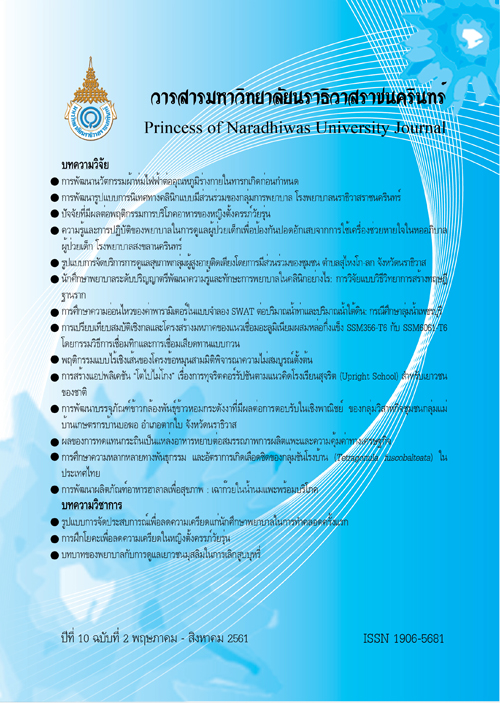การศึกษาความอ่อนไหวของค่าพารามิเตอร์ในแบบจำาลอง SWAT ต่อปริมาณน้ำาท่า และปริมาณน้ำาใต้ดิน: กรณีศึกษาลุ่มน้ำาเพชรบุร
คำสำคัญ:
SWAT, ความอ่อนไหวของค่าพารามิเตอร์, ปริมาณน้ำาท่า, ปริมาณน้ำาใต้ดิน, ลุ่มน้ำาแม่เพชรบุรีบทคัดย่อ
แบบจำาลอง SWAT เป็นแบบจำาลองหนึ่งที่นิยมมาใช้งานสำาหรับการประเมินทรัพยากรน้ำา การวางแผน และการ
จัดการทรัพยากรน้ำาในปัจจุบันและอนาคต เนื่องจากเป็นแบบจำาลองแบบกระจายค่าพารามิเตอร์ ซึ่งในการนำาแบบจำาลองมาใช้
ผู้ใช้ต้องกำาหนดค่าพารามิเตอร์ให้เหมาะสมกับสภาพพื้นที่การศึกษา โดยงานวิจัยนี้มีวัตถุประสงค์เพื่อศึกษาความอ่อนไหวของ
ค่าพารามิเตอร์จากแบบจำาลอง SWAT ที่ส่งผลต่อปริมาณน้ำาท่าและปริมาณน้ำาใต้ดิน กรณีศึกษาพื้นที่ลุ่มน้ำาเพชรบุรี โดยใช้
ดัชนีความอ่อนไหวเป็นตัวกำาหนดความอ่อนไหวของค่าพารามิเตอร์ ผลการศึกษาพบว่าพารามิเตอร์ที่มีค่าดัชนีความอ่อนไหว
ต่อปริมาณน้ำาท่ามากที่สุด 4 อันดับ ได้แก่ ค่า curve number (Cn2) ค่าปริมาณน้ำาที่ดินสามารถเก็บไว้ได้ (Sol_Awc) ปัจจัย
ชดเชยการระเหยจากผิวดิน (Esco) และค่าความสามารถการนำาน้ำาของดิน (Soil_K) ตามลำาดับ และพบว่า พารามิเตอร์ที่มีค่า
ดัชนีความอ่อนไหวต่อปริมาณน้ำาใต้ดินมากที่สุด 5 อันดับ ได้แก่ ค่าปริมาณที่ดินสามารถเก็บไว้ได้ (Sol_Awc), ความล่าช้าของ
ปริมาณน้ำาใต้ดิน (Gw_Delay) ปัจจัยชดเชยการระเหยจากผิวดิน (Esco) ค่าความสามารถการนำาน้ำาของดิน (Soil_K) และค่า
curve number (Cn2) ตามลำาดับ ซึ่งจากผลการศึกษาครั้งนี้สามารถนำาไปประยุกต์ใช้ในการปรับเทียบและตรวจพิสูจน์แบบ
จำาลองเพื่อนำาไปใช้ในการประเมินปริมาณน้ำาท่าของพื้นที่ลุ่มน้ำาเพชรบุรีได้ให้มีความแม่นยำามากยิ่งขึ้นต่อไป
เอกสารอ้างอิง
Baumgartner, A. & Rcichel, E. (1976). Climate and energy exchange in the Gulf of Aqaba (Eilat). Monthly Weather Review, 104(1), 381-358
Khanal, S. & Parajuli, P.B. (2014). Sensitivity Analysis and Evaluation of Forest Biomass Production Potential Using SWAT Model. Journal of Sustainable Bioenergy Systems, 4(1), 136-147.
Lenhart, T., Eckhardt, K., Fohrer, N., & Frede, H.G. (2002). Comparison of Two Different Approaches of Sensitivity Analysis. Physics and Chemistry of the Earth, 27(9), 645-654.
Neitsch, S.L., Arnold, J.G., Kiniry J.R. & Williams, J.R. (2005). Soil and Water Assessment Tool Theoretical
Documentation (Version 2005). Retrieved January 20, 2012, from :http://swatmodel.tamu.edu/
media/1292/SWAT2005theory.pdf
Pongpetch, N. & Pongpetch, S. (2013). Simulation of Stream Flow for Upper Lam Takongsub-Watershed
Using SWAT Model. International Journal of Environmental Science and Development, 4(3), 261-263
Thangtham, N. (2004). Hydrographic soil. Bangkok, Thailand: Kasetsart University.
Suwanlertcharen, T. (2011). Application of the SWAT Model to Evaluate Runoff and Suspended Sediment
from a Small Watershed: A Case Study of Mae Phun Subwatershed, Laplae District, Uttaradit
Province. Master’s thesis. Kasetsart University. (in Thai).
White, K.L. & Chaubey, I. (2005). Sensitivity Analysis, Calibration, and Validations for a Multisite and
Multivariable SWAT Model. Journal of the American Water Resources Association, 5(1), 1077-1089.




